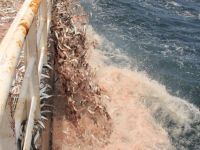Food supplies: The Blue World approach
As demand for food soars, and as the worldwide consumption of fish has doubled in the last few decades, the focus these days is on the Blue World approach, placing the emphasis on conservation of stocks and sustainable fishing practices, balancing management of aquatic stocks with equitable benefits for those living in coastal communities.

The UNO's Food and Agriculture Organization's latest report, The State of World Fisheries and Aquaculture, lays out the challenges facing the world today as soaring population growth - set to be some 10 billion by 2050, rising from 7 billion today - demands the production of more and more food.
Fisheries and aquaculture provided 158 million tonnes of production in 2012, 85 per cent of this (136 million tonnes) being used for food (the rest for by-products) and fish represents around 17 per cent of the global intake of protein (a figure which reaches some 70 per cent in some coastal areas), while providing jobs for up to 12 per cent of the world's population. 94 per cent of people working in this area live in Asia (84%) and Africa (10%), the remaining 6% living in the Americas, Europe and Oceania.
The industry is worth 130 billion USD per year and has witnessed a growing trend in consumption, from 10 kilogrammes per person per year in 1965 to around 19 kilogrammes per person per day in 2012.
The focus today is on Blue Growth, based on sustainable and responsible management of fisheries worldwide, in a Blue World which sees fish stocks accompanying the growth in demand, providing jobs and bringing equitable benefits to those who live from fishing and aquaculture.
This entails combatting overfishing, and among the policies under the spotlight are subsidies which promote this, alongside a greater emphasis on studying the impacts of climate change and changing ocean currents on fisheries. The terms Blue Growth, Blue Economy and Blue World stem from the 2012 UN Conference on Sustainable Development (Rio +20).
The good news is that according to the UNO's Food and Agriculture Organization, over seventy per cent of wild fish stocks are today fished inside biologically sustainable levels. The bad news is that one third of stocks are not, and also around one third of fish caught is wasted. See this article, compliments to Morocco and the European Union:
https://english.pravda.ruhttps://english.pravda.ru/opinion/126195-morocco_western_sahara/
As we speak about food production and the need to cater for the needs of a rising population, let us network and inform each other about the growing opportunities in the area of sustainable and biological production, countering the lies of those who claim that only by growing GM crops and practicing production methods using growth hormones and other chemical substances can we keep pace with demand. This is simply not true.
And now we are on the topic, let us also make our own demands for clearer labelling of food products on the packages, including ld fish stocks ands of fish back into the sea, dead, because they were " longer periods of time. kages, incluwarnings for those products harmful to the health if consumed in excess or over longer periods of time. This is another debate but a connected one.
Photo: wsrw.org
A Moroccan vessel spews thousands of fish back into the sea, dead, because they were "too small".
Timothy Bancroft-Hinchey
Pravda.Ru
Subscribe to Pravda.Ru Telegram channel, Facebook, RSS!





